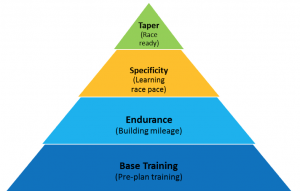Martin Hulbert is a vastly-experienced 43-year-old amateur runner for the Wigston Phonix Leicester Running Club. This is the first of five guest blogs he will be writing for Function Jigsaw. Each one will describe the countdown to his 11th London Marathon in April. He will be explaining his tried and tested training methods.
I’m Martin Hulbert and over the next five months I am going to take you on a journey; a running journey. Next year, on Sunday April 23 to be exact, I will be running my tenth consecutive London Marathon (my 11 in total). “Why?” you may ask. My answer will always be two-fold;
1) I run for a local charity every year and
2) I absolutely love the race
I also love running. In fact, because I enjoy it so much, I run nearly every day. I am a member of a Leicestershire running club, Wigston Phoenix, and for them I participate in the Leicestershire Road Running League races throughout the summer. Apart from these races, nearly all my other runs are at an easy pace, often across the fields and canal towpaths enjoying the scenery.
Come November each year though, I start to plan for my next London Marathon. My first target, as every year, is to achieve my ‘Good For Age’ time to guarantee a place for the following year. At the age of 43 it means I must run 26.2 miles in less than 03:15:00. My actual race-day target will not be decided until late March, but I will be training to a pace which should, all being well, get me to finish in around 2:45:00.
Marathon Race Day
I have already written my training plan for 2017, which is based around my plan for the last three years where I have achieved my personal best of 2:44.50 and two years of running for ‘fun’ (2:53.38 & 2:52.04).
Most people who have entered a spring marathon will be thinking about looking for a training plan, with most of these covering 16 weeks up to the marathon race day. Conveniently, for those running London, these plans start on January 2.
One thing that most of the ‘off the internet’ plans do not tell you, is how to get ready for the plan. Week One of the internet plans will expect you to run X amount of miles in that first week with a long run of X miles. A lot of people are not prepared for this first week, jumping straight into a plan without giving thought to making sure they can sustain the mileage set out for them, resulting in injury and failure to reach the start line fit. Almost a third of runners do not make race day.
Therefore, now is the time to build your weekly mileage, sensibly, adding one mile a week to your long run and making sure you can get to the starting point of your 16-week plan. If not, have a re-think about your target or the plan you want to follow. If you think about building a house; without the strong base, everything you put on top will eventually collapse.
For the next five weeks my long runs will be 13, 14, 14, 15, 16 miles respectively and I will be aiming to run at least 50 miles each week. Remember that this is my plan and your long runs will be aimed at getting you from where you are at present to where you want to be at the start of your training plan. The weekly mileages and long-run distances are different, but the process is the same. I will then have a slightly easier week between Christmas and New Year (this is the law according to my wife) and I will then be raring to go on January 2.
Martin Hulbert is a Personal Training and writes personalised training plans for runners. For more information visit www.mhhealthandfitness.co.uk or on Facebook at https://www.facebook.com/mhhealthandfitness.co.uk/
Like this? Read More; Leicester Marathon; an inspirational day for all involved









